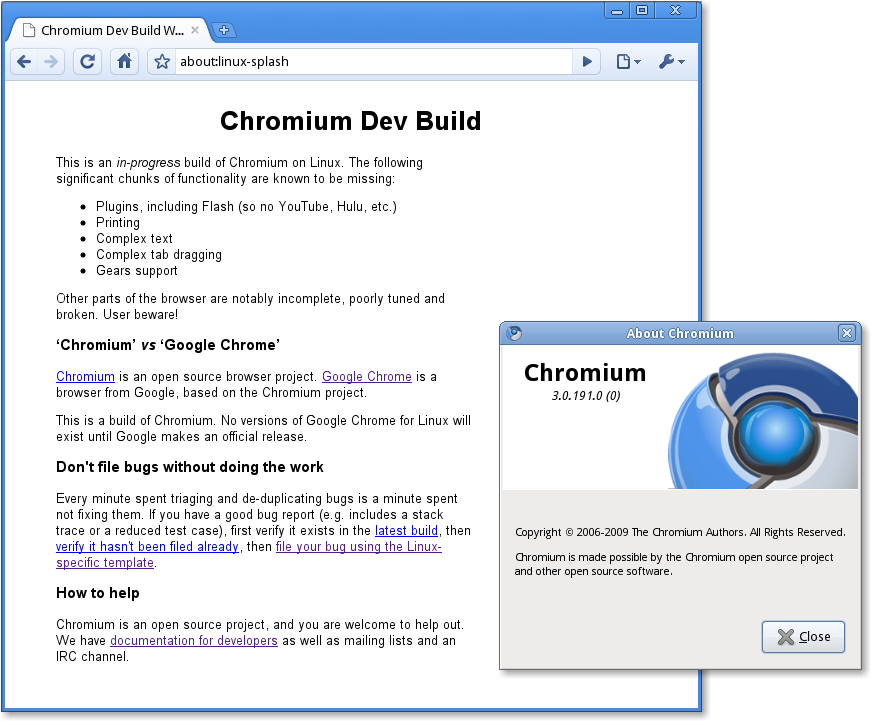Internet
The Internet protocol suite (TCP/IP) resulted from research and development conducted by the Defense Advanced Research Projects Agency. It was led by Vinton Cerf and Robert E. Kahn, who openly shared the protocol at the IEEE Transactions on Communications in May 1974.
BIND
BIND (Berkeley Internet Name Domain) is an implementation of the Domain Name System (DNS) of the Internet. The software was originally written by Douglas Terry, Mark Painter, David Riggle and Songnian Zhou at the University of California, Berkeley. It was later maintained by Paul Vixie.
WorldWideWeb
While working at CERN (European Organization for Nuclear Research), Tim Berners-Lee laid out his vision for what would become the web in a document called "Information Management: A Proposal."

WWW Implementation
Berners-Lee was encouraged by his boss, Mike Sendall, to begin
implementing his system on a newly acquired NeXT workstation. He
formalized the proposal together with his colleague Robert
Cailliau and by Christmas 1990, he had built all the tools
necessary for a working Web: the HyperText Transfer Protocol
(HTTP), the HyperText Markup Language (HTML), the first Web
browser (named WorldWideWeb, which was also a Web editor), the
first HTTP server software (later known as CERN httpd), the first
web server (http://info.cern.ch), and the first Web pages that
described the project itself.
Line Mode Browser
Berners-Lee recruited Nicola Pellow, a math student intern working at CERN, to write the Line Mode Browser, a cross-platform web browser that displayed web-pages on old terminals and was released in May 1991.
First Website
The first website went live on August 6, 1991. It was dedicated to the World Wide Web project itself and was hosted on Tim Berners-Lee's NeXT computer. The project was announced on the Internet (alt.hypertext newsgroup).

Web in U.S.
Paul Kunz from the Stanford Linear Accelerator Center (SLAC) visited CERN in September 1991, and was captivated by the Web. He brought the NeXT software back to SLAC, where librarian Louise Addis adapted it for the VM/CMS operating system on the IBM mainframe as a way to display SLAC's catalog of online documents; this was the first Web server outside of Europe and the first in North America.
ViolaWWW
ViolaWWW was the first popular browser for the World Wide Web. It was the invention of Pei-Yuan Wei, a member of the eXperimental Computing Facility (XCF) at the University of California, Berkeley.
libwww
Tim Berners-Lee and a student at CERN named Jean-François Groff rewrote various components of the original WorldWideWeb browser to form libwww (initially called the Common Library). Tim Berners-Lee licensed libwww as public domain to encourage the development of web browsers.
NCSA HTTPd
NCSA HTTPd web server first public release. Rob McCool started developing the NCSA HTTPd while he was an undergraduate at the University of Illinois at Urbana–Champaign.
Open Web
On 30 April 1993, CERN put the World Wide Web software in the public domain. CERN made the next release available with an open license, as a more sure way to maximize its dissemination. Through these actions, making the software required to run a web server freely available, along with a basic browser and a library of code, the web was allowed to flourish.
Mosaic
NCSA Mosaic was the web browser that popularized the World Wide Web. Marc Andreessen and Eric Bina developed Mosaic while at NCSA at the University of Illinois at Urbana–Champaign. It was first published in June 1993.

Yahoo!
In January 1994, Yahoo! was founded by Jerry Yang and David Filo, then students at Stanford University. Yahoo! Directory, launched in January 1994, became the first popular Web directory. Yahoo! Search, later launched in 1995, became the first popular search engine on the World Wide Web.

WWW Conference
In May 1994, the first International WWW Conference, organized by Robert Cailliau, was held at CERN; the conference has been held every year since.
Web Commerce
Web commerce began emerging in 1995 with the founding of Amazon by Jeff Bezos and eBay by Pierre Omidyar.
Netscape
Marc Andreessen and Jim Clark founded what would become Netscape Communications Corporation and launched their first browser on September 9, 1994. Originally it was called Mosaic Netscape, but it was renamed as Netscape Navigator to avoid trademark problems with NCSA. The internal codename for the browser was Mozilla, which stood for "Mosaic killer" and indeed it rapidly became the most popular browser.

World Wide Web Consortium
The World Wide Web Consortium (W3C) is the main international standards organization for the World Wide Web. It was founded in 1994 by Tim Berners-Lee after he left the European Organization for Nuclear Research (CERN). The consortium was founded at the Massachusetts Institute of Technology Laboratory for Computer Science (MIT/LCS) with support from the European Commission, the Defense Advanced Research Projects Agency (DARPA), which had pioneered the ARPANET, one of the predecessors to the Internet.

Cascading Style Sheets
Cascading Style Sheets (CSS) was first proposed by Håkon Wium Lie on October 10, 1994. At the time, Lie was working with Tim Berners-Lee at CERN. He co-authered CSS 1 with Bert Bos on December 17, 1996.
Apache httpd
A small group of webmasters known as the Apache Group came together with the goal of releasing a common distribution based on multiple "patches" to the NCSA HTTPd Server. The first official public release (0.6.2) of the Apache web server was on April 1995.

Opera
In 1994, Jon Stephenson von Tetzchner and Geir Ivarsoy started developing the Opera web browser while working at Telenor, a Norwegian telecommunications company. In 1995, they founded Opera Software AS and released Opera in April 1995.

JavaScript
Marc Andreessen imagined a more dynamic Web and believed that a language easy to use by Web designers was needed. He recruited Brendan Eich, who in 10 days wrote a prototype for the Netscape browser in May 1995. The language was first called Moca, later LiveScript, and finally renamed JavaScript (to serve as a companion language to Java). The official public announcement of JavaScript was on December 4, 1995.

PHP
Originally created by Rasmus Lerdorf in 1994, PHP was released publicly on June 1995.

Internet Archive
Brewster Kahle founded the Internet Archive in May 1996 at around the same time that he began the for-profit web crawling company Alexa Internet. It provides free public access to collections of digitized materials, including websites, software applications/games, music, movies/videos, moving images, and millions of books.

Netscape Open Sourced
In January 1998, Netscape Communications Corporation released the code for Netscape Communicator as open source, influenced by the Eric S. Raymond's essay "The Cathedral and the Bazaar," in the hopes that it would become a popular open- source project. Netscape placed the code under the Netscape Public License, which was similar to the GNU General Public License, and started the Mozilla project to coordinate its development.

Web Standards Project
Founded in 1998, the Web Standards Project (WaSP) campaigned for standards that reduced the cost and complexity of development while increasing the accessibility and long-term viability of any document published on the Web. WaSP worked with browser companies, authoring tool makers, and peers to encourage them to use these standards
RSS
RSS (RDF Site Summary or Really Simple Syndication) is a web feed that allows users and applications to access updates to websites in a standardized, computer-readable format. These feeds can, for example, allow a user to keep track of many different websites in a single news aggregator.
RDF Site Summary, the first version of RSS, was created by Dan Libby and Ramanathan V. Guha at Netscape. It was released in March 1999 for use on the My.Netscape.Com portal. This version became known as RSS 0.9. In July 1999, Dan Libby of Netscape produced a new version, RSS 0.91, which simplified the format by removing RDF elements and incorporating elements from Dave Winer's news syndication format. Libby also renamed the format from RDF to RSS Rich Site Summary.

Semantic Web
The Semantic Web is an extension of the World Wide Web to make Internet data machine-readable. To enable the encoding of semantics with the data, technologies such as Resource Description Framework (RDF) and Web Ontology Language (OWL) are used. Tim Berners-Lee originally expressed his vision of the Semantic Web in 1999 as follows:
I have a dream for the Web [in which computers] become capable of analyzing all the data on the Web – the content, links, and transactions between people and computers. A "Semantic Web", which makes this possible, has yet to emerge, but when it does, the day-to-day mechanisms of trade, bureaucracy and our daily lives will be handled by machines talking to machines. The "intelligent agents" people have touted for ages will finally materialize.
Wikipedia
In January 2001, Wikipedia began as a side-project of Nupedia, to allow collaboration on articles prior to entering the peer-review process. The name was suggested by Sanger on 11 January 2001 as a portmanteau of the words wiki (Hawaiian for "quick") and encyclopedia. The wikipedia.com and wikipedia.org domain names were registered on 12 and 13 January, respectively, with wikipedia.org being brought online on the same day. The project formally opened on 15 January ("Wikipedia Day"), with the first international Wikipedias – the French, German, Catalan, Swedish, and Italian editions – being created between March and May.

Mozilla Foundation
Mozilla Foundation was launched on July 15, 2003, as a spun-off of Netscape/AOL. The Mozilla Foundation has evolved beyond the initial role of supporting the Mozilla project to become an organization that promotes openness, innovation and participation on the Internet.

WHATWG
The Web Hypertext Application Technology Working Group (WHATWG) was founded by individuals from Apple Inc., the Mozilla Foundation and Opera Software. The WHATWG was formed in response to the slow development of W3C Web standards. In 2007, the group proposed that the new HTML working group of the W3C adopt the WHATWG's HTML5 as the starting point of its work.
Firefox
Firefox began as an experimental branch of the Mozilla project by Dave Hyatt, Joe Hewitt, and Blake Ross in 2002. To combat what they saw as the Mozilla Suite's software bloat, they created a stand-alone browser, first named Phoenix, later Firebird, and finally Firefox. Firefox version 1.0 was released on November 9, 2004. Firefox's speed, usability, and marketing helped it gain market share against Internet Explorer. Within five years of launching, Firefox accounted for nearly a third of all web browsing.

Microformats
Microformats (sometimes abbreviated μF) are a set of defined HTML classes created to serve as consistent and descriptive metadata about an element, designating it as representing a certain type of data (such as contact information, geographic coordinates, events, blog posts, products, recipes, etc.). They allow software to process the information reliably by having set classes refer to a specific type of data rather than being arbitrary. Microformats emerged around 2005 and were predominantly designed for use by search engines and aggregators such as RSS.

jQuery
jQuery is a JavaScript library that was designed by John Resig to simplify HTML DOM tree traversal and manipulation, as well as event handling, CSS animation, and AJAX.

Chromium
Google released the Chrome browser on December 11, 2008, using the same WebKit rendering engine as Safari and a faster JavaScript engine called V8. Shortly after, an open-sourced version for the Windows, OS X, and Linux platforms was released under the name Chromium. With a rapid release cycle and a focus on speed, Google Chrome eventually overtook all other browsers.

Node.js
Node.js was initially developed by Ryan Dahl in March 2009 based on Google's open source V8 JavaScript engine. It paved way to the use of JavaScript on Web servers. Node.js functions are non-blocking, allowing the server to handle a high load of concurrent connections. It represents a 'JavaScript everywhere' paradigm, unifying web-application development around a single programming language.

Web Foundation
The World Wide Web Foundation, also known as the Web Foundation, is a non-profit organization advocating for a free and open web for everyone. It was co-founded by Tim Berners-Lee and Rosemary Leith.

Contract for the Web
Contract for the Web is an initiative by the World Wide Web Foundation in November 2019 to attempt to address issues of political manipulation, fake news, privacy violations, and other malign forces on the internet.